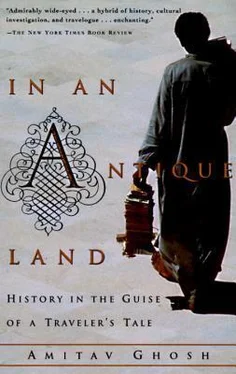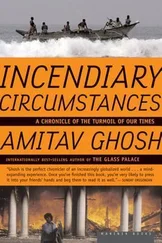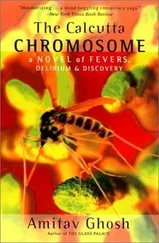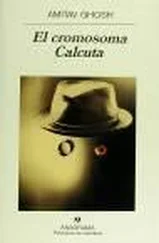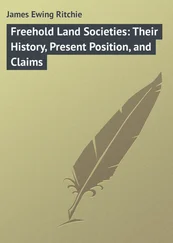The greatest achievement of the Ben Ezra congregation, however, was the product of largely fortuitous circumstances. The Synagogue’s members followed a custom, widespread at the time, of depositing their writings in a special chamber in the synagogue so that they could be disposed of with special rites later. This practice, which is still observed among certain Jewish groups today, was intended to prevent the accidental desecration of any written form of God’s name. Since most writings in that epoch included at least one sacred invocation in the course of the text, the custom effectively ensured that written documents of every kind were deposited within the Synagogue. The chambers in which the documents were kept were known by the term ‘Geniza’, a word that is thought to have come into Hebrew from a Persian root, ganj, meaning ‘storehouse’—a common element in place-names in India and Iran, particularly beloved of the British who sprinkled it liberally across their Indian settlements, in odd Anglicized forms like ‘Ballygunge’ and ‘Daltongunj’.
Every synagogue in the Middle East once had a Geniza and in accordance with custom, their contents were regularly emptied and buried. The Geniza of the Synagogue of Ben Ezra was added when the synagogue was rebuilt in 1025AD, but for some reason — possibly reverence for the past, possibly mere oversight — it was never cleared out. For more than eight centuries papers continued to accumulate inside the Geniza. At the peak of the community’s prosperity, during the first two and a half centuries after the rebuilding of the Synagogue in 1025, great quantities of manuscripts poured in. Then, towards the middle of the thirteenth century, the flow dried to a trickle, and only swelled again some three hundred years later, when the Spanish Inquisition sent yet another wave of Jewish immigrants flooding in to Egypt. Papers (and later, books) continued to accumulate intermittently in the Geniza until the nineteenth century, by which time Fustat had become a poor neglected backwater in Cairo’s rapidly expanding archipelago. The document that is thought to be the last to be deposited in the Geniza bears the date 1875: it was a divorce settlement written in Bombay.
For centuries the Synagogue of the Palestinians lay forgotten within the half-abandoned precincts of the ancient fortress of Babylon. In about 1890, the eleventh-century building, the structure that Ben Yiju saw, was finally torn down and a new one was erected in its place: it still stands on the site today.
Until recently the site of the Synagogue of Ben Ezra lay at one end of a plateau of rubble; an expanse of shattered brick and stone, that looked as though it had been flattened by a gigantic hammer. The Synagogue itself, an undistinguished, rectangular building, seemed just barely to have survived: much of its masonry had crumbled, and the shutters had fallen away from many of its windows. Its most striking feature was a pair of wrought-iron gates; although much discoloured and corroded, they were still graceful, their sinuous forms exuberantly Art Deco: they looked as though someone had ordered them from Paris in a flush of enthusiasm after a summer holiday. Above the narrow gateway, held in place by a length of iron tubing and a few heavy stones, was a Star of David, a little askew and festooned with cobwebs.
Today the building is once again rejuvenated, its exterior scrubbed and well-tended. Prefabricated huts have sprouted in the rubble outside, where young engineers stand behind drawing-boards, their toes tapping gently to the beat of muted rock music: a team of Canadian experts and restorers has arrived, Mountie-like, to rescue the Synagogue from the assaults of Time.
A few men wait for tourists at the entrance to the Synagogue, standing behind desks spread with beads, necklaces, bronze scarabs and busts of Nefertiti. One of them has been there for years, a plump, smiling man, dressed in a shirt and trousers. His trinkets and souvenirs do not seem to change much from year to year — in fact he never seems to do much business at all — but he is always full of smiles, good-natured, and helpful. He explains that ‘Amm Shahata, the caretaker, is inside, he can take visitors in and explain everything — he is Jewish, yahûdi, he knows all about the Synagogue.
In a while ‘Amm Shahata appears, a sprightly old man, very thin and a little stooped. He too is dressed in a shirt and trousers, and his skull-cap is very much like any Egyptian Muslim’s. The two men exchange some companionable banter; his Arabic is indistinguishable from theirs, the staccato speech of working-class Cairo. He tells you his name: ‘Nathan in Hebrew and Shahata in Arabic.’ Close up he looks unexpectedly old, his teeth are gone and veins stand out on his forehead.
‘Amm Shahata soon lets it be known that he is a busy man: he has no time to waste; he ushers you briskly through the gateway and leads you into the main chamber of the Synagogue. Prisms of light shine through coloured windows; you are in a room with a very high ceiling, but otherwise of modest, schoolroom size. In the centre is a raised, octagonal altar, with benches arranged in rows on either side. The room has two levels. At the upper level is the women’s gallery, which runs around three sides of the room. At the far end of the gallery, on the left, is a small hole, high up in the wall; it opens into an empty chamber adjoining the back wall. ‘Amm Shahata points at the opening; that is the Geniza, he tells you, where a lot of papers were found, years and years ago.
You wish it were indeed the old Geniza, but it cannot be. It is no higher than a bare six feet or so while the Geniza of the old Synagogue is known to have been at least as tall as the rest of the building, some two and a half storeys high. The old Geniza was probably left standing for a while, after the rest of the structure was torn down, but it must have perished later.
Of course, you have no cause to be disappointed. The Synagogue’s location has not altered, whatever the changes in its outer shell. The fact is that you are standing upon the very site which held the greatest single collection of medieval documents ever discovered.
It was here, in this forlorn corner of Masr, that the memories of Abraham Ben Yiju and his slave lay preserved for more than seven hundred years.
6
ONCE, ON A very hot afternoon, when the sweat was dribbling off my face on to my notebooks, I gave up trying to work, and sat in my room with the door open, hoping to trap a breath of fresh air. It was very still that day, with the moisture from the freshly-watered cotton fields and rice paddies hanging heavy in the air. At intervals, as though frightened by the stillness, the ducks and chickens with whom I shared the roof would burst into an uproar, erupt out of their coops and flap around the roof in a gale of frenzied squawks, undaunted by the flat, white heat of the afternoon.
As I sat watching, a pair of ducks began to race around and around the roof, one in pursuit of the other. They were of a species I had never seen before I came to Egypt: squat, ugly creatures, almost suicidally self-absorbed, with large red warts on their necks and mangy black and white bodies. The pursuer was the bigger of the two, and it soon caught up with the other and pinned it to the floor with its beak. Then, after it had hoisted itself on top, it raised one leg and suddenly its penis appeared, a bright, wet pink, about as long as a thumbnail. It flapped its tailfeathers for a moment, pressing against its mate, and then tumbled off, a look of bafflement on its face. I watched spellbound: I had had no conception that ducks had penises and vaginas.
I happened to look up then and I saw Jabir, standing silently in the stairway, watching me.
He began to laugh.
Читать дальше
